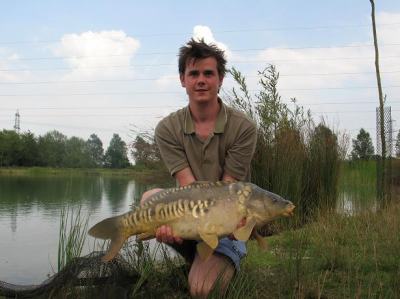My last two sessions on the Day Ticket lake were when it was really hot, so I had a little go on the surface. To cut a long story short, on the first Sunday afternoon session I managed to catch 5 carp and Gary Dear, one of the regular Bayeswater anglers also had 2 fish on my rods. I was only there for about 3 hours as I had to go and do an interview for Carp Addict magazine. Once I had them feeding well, the bites were almost instant, which proves that it is worth the effort to get baits on them. I must admit it was a bit frustrating to start with as the wind kept changing all the while. I had to spod the free offerings well out to ensure there was always plenty of feed in the open water.
The second session was a bit easier on the following Monday evening. The wind was blowing lightly off the point swim, peg 13, so I tipped some pellet in the margins for the wind to pick up and catapulted some a bit further out. They were straight on it and I had the first one on before I could get the second rod out. I ended up with 8 carp to mid doubles in about 2 hours. They were still munching the pellet when I left, but my floater gear doesn’t involve a head torch and I had a job to see what I was doing! The wind was also chopping and changing a bit as well and I had to keep alternating between pegs 12 and 13 to keep a good line to my controllers.

Gary Dear with a fish on my rod

Gary playing his second fish "off the top"
Looking out of the window today, I wonder if it’s worth mentioning anything about surface fishing at all. The thing is though, if you turn up at Bayeswater when it’s hot, it’s quiet easy to catch them off the top. So it’s always a good idea to be prepared.
There are several good floater methods that will catch carp, but here is my favourite way. I caught on it last year and twice this year in just a few hours fishing, so it’s worth a go and it’s easy.
I’ve always found floater fishing too frustrating with large, chum mixer type baits, what with the seagulls and ducks there are on most waters. I use the smallest floating coarse fish pellets I can find instead. The wildlife tend to leave it alone, or at least don’t come and clean the whole lot up in one go like they do with the chummy’s.
The only down-side to using small 4mm floating pellet is they are not so easy to get out. Also, if the wind is always changing, it is hard to see where they are unless the fish are mopping them up, but that can also be a problem with larger feed.
The feeding methods I use with the 3-4mm pellets are easy enough. If the wind is directly behind me, I simply tip some pellet in the margins and catapult some out at maximum distance with a few pouch-fulls in between. This gives a good feeding line and it’s easy to keep this line by simply adding to the margins, the wind does the rest. This is all it took on my second session above.
If the wind is all over the place, or I want to feed further out, then I either catapult PVA mesh bags of pellet out or spod the pellet out. I started the first session above catapulting PVA mesh bags, but got them going better spodding. If you decide to spod the pellet out, then 2 floater rods is better – you can fish the spod spill area and the longer range area where the spod lands. If possible, it pays to spod up-wind because the fish tend to get on it after it has drifted a few metres. I find the bigger the spod the better, then you only have to fill it about two thirds full to reduce the spill a bit.

Catapult, PVA and spod to feed the small pellet
Spodding is the best method in my mind; it’s cheaper and spreads the pellet more. I have observed that nearly all the pellet (that doesn’t spill out) is discharged as the spod impacts on the surface, but I still give the spod a few sharp tugs before retrieving it. I’ve tried taping some of the holes up on the spod, but don’t see that it makes any difference. Floating pellet isn’t heav,y so it spods out easy in the bigger spods.

Nash controller
As I said, there are a lot of different methods and rigs you can use for floater fishing, but I prefer the Nash Bolt Machines. As the name suggests, they are a self hooking set up, which makes it easier to detect the bites. My eyes are good, but I do struggle to see critically balanced hookbaits at 40 to 100 metres plus, so it’s much easier to fish bolt machine style. It also makes fishing 2 rods, feeding and observing more relaxing, instead of holding a rod and concentrating on hitting the slightest movement on the lighter conventional controllers. I use the middle size Bolt Machine Distance controller, as it will cast plenty far enough and offers a little bit more distance than the smaller version. The Bolt Machine Extreme is too big and heavy for Bayeswater and is designed for fishing very long range with leaders on vast reservoirs.
My main line choice is 20lb Fireline, a floating braid, but especially if there is a cross wind normal mono is a better choice. I only use the braid because it is such a good casting line and it is on the two rods I use for floater fishing. Mono will sink and in effect hold the controller in position although it also "drags" the controller in a few metres, whereas my braid floats but really "drags" the controller round down wind, into the path of feeding fish but sometimes too fast to get a take. Sometimes the braid is best and sometimes it is a pain. Still, that’s life.

The terminal tackle I use
Hooklink-wise, I prefer fluorocarbon, but also use Drennan Double Strength. 12lb is about right, although in the main body of the lake I have used 6lb before. The flourocarbon is heavier than water and needs to be lightly greased from the controller to within about 20-30cm of the hook. If you don’t grease it, the hook bait will end up too near the controller. I use the sweat around my ears and nose to grease the hook link. I have used Vaseline before, but it ends up too thick, giving the effect of much thicker, stronger line and can spook the fish. If you do use flourocarbon, don’t use the knot-less knot as this weakens the flouro by about a third. 12lb will end up as 8lb. The Polamar knot is the strongest knot for flourocarbon.
I use about 8ft hooklinks, but because of the hook knot slipping and the hair rig sometimes getting twisted, I re-tie the hook a lot and end up with as short as 4ft hook
links sometimes. 8ft hooklinks are tricky to cast so I lay the hook and some of the hooklink on the floor to cast. To stop the grass and weeds catching the hooklink the un-hooking mat acts as a good base to rest the hook on.

The shorter hair rig method
Hair rig wise, it depends on the day. Fishing 2 rods allows a bit of experimentation. Long hairs work well most of the time, but on the Sunday session I did better on short hairs, as in the picture. I’m sure that plastic baits with clever weights which hold the hook out of the water work, but I seem to catch plenty without using plastic.
Hook bait wise, I use a variety of chopped down 15 or 20mm pop-ups and single 10mm pop-ups, usually our Scopex Squid in the yellow colour, although I’ve caught them on all types of colours including purple. They do have preferences, so try a few different baits. I find that the cut down 15 or 20mm baits are excellent for making critically balanced baits that only just hold the size 10 hook up to sit on the surface. This helps the bait to be sucked in better, hooking the fish better.
That’s about it for my surface fishing technique. Next time it’s hot, try it.
{Editor’s Note: This is our first contribution from Gary. The lake that he refers to is one of his own at http://www.bayeswaterfishing.co.uk/ – check it out, as he’s really doing wonderful things with these lakes)








